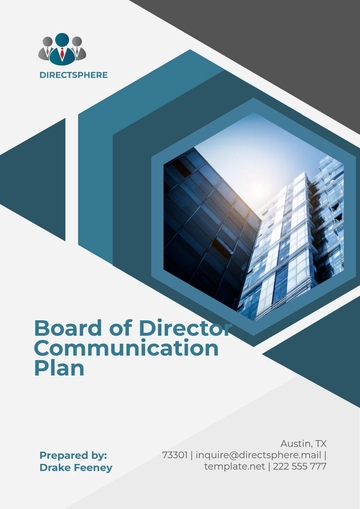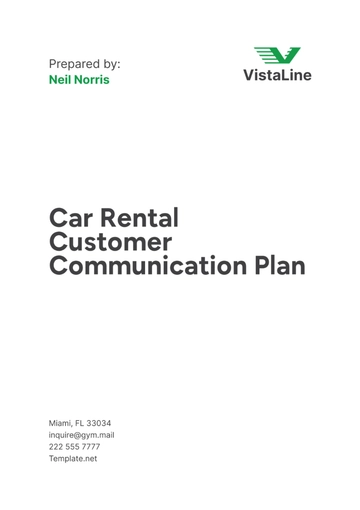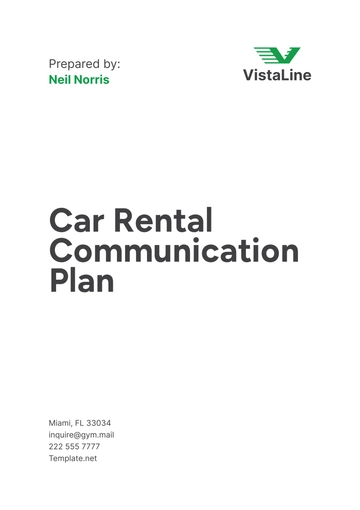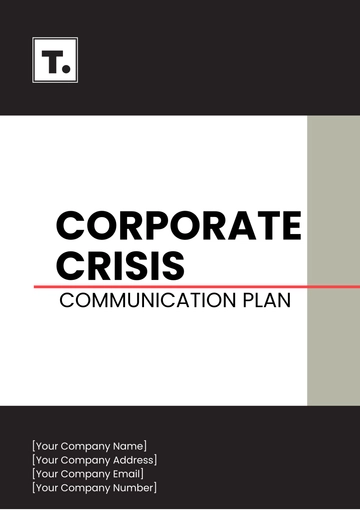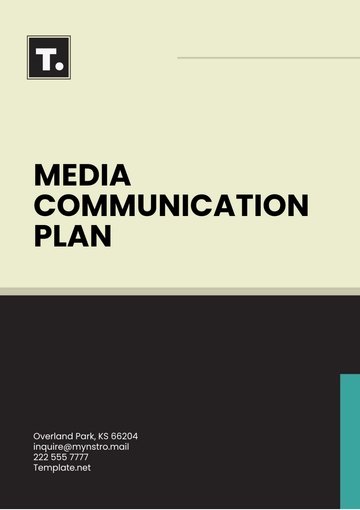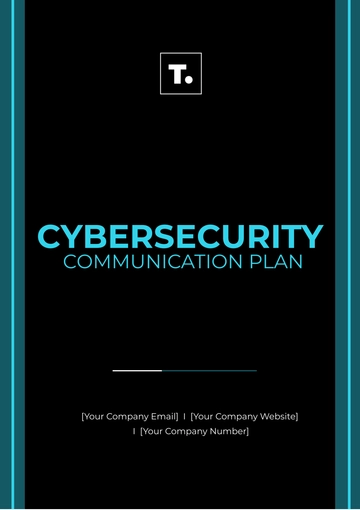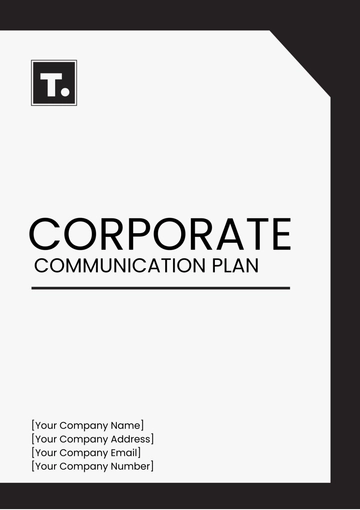Free Restaurant Communication Plan

I. Introduction
A. Purpose
The purpose of this Restaurant Communication Plan is to establish clear and effective communication strategies for [Your Company Name], a leading establishment in the culinary industry. By implementing this plan, we aim to not only ensure seamless communication within our organization but also to strengthen relationships with our customers, suppliers, and the community at large. Our goal is to uphold the reputation of [Your Company Name] as a provider of exceptional dining experiences, characterized by outstanding service and culinary excellence.
B. Scope
This communication plan encompasses a comprehensive approach to communication management, covering both internal and external stakeholders of [Your Company Name]. It includes protocols for communication channels, messaging guidelines, crisis communication procedures, and evaluation metrics. The scope extends to all employees, from front-of-house staff to kitchen personnel, as well as management, suppliers, customers, and media representatives. By implementing this plan, we seek to foster a culture of effective communication that aligns with the values and objectives of [Your Company Name].
II. Objectives
Ensure consistent and transparent communication across all channels: We strive to establish standardized communication practices that promote clarity, consistency, and transparency in all interactions, both internal and external.
Improve customer service and satisfaction by addressing their needs promptly and effectively: We are committed to enhancing the dining experience for our customers by maintaining open lines of communication, addressing feedback promptly, and exceeding their expectations.
Enhance internal communication and collaboration among staff members to optimize operational efficiency: We aim to foster a collaborative work environment where information flows freely, enabling our team members to work cohesively towards common goals and objectives.
Increase brand awareness and customer engagement through strategic marketing communication: We seek to leverage various communication channels to promote [Your Company Name], engage with our target audience, and strengthen brand loyalty among customers.
Manage and mitigate communication-related issues and crises to protect the reputation of [Your Company Name]: We are committed to proactively identifying and addressing communication challenges and crises, ensuring swift and effective resolution to safeguard the reputation and integrity of [Your Company Name].
III. Key Stakeholders
A. Internal Stakeholders
Management Team: Comprising executives and department heads responsible for setting strategic direction, overseeing operations, and ensuring the effective implementation of communication strategies.
Staff Members: Including kitchen staff, waitstaff, bartenders, and administrative personnel. They play a crucial role in delivering exceptional customer service and maintaining operational excellence.
Marketing Team: Responsible for developing and executing marketing campaigns, managing social media channels, and enhancing brand visibility both online and offline.
Human Resources: Facilitating internal communication, training programs, and employee engagement initiatives to foster a positive work environment and promote staff morale.
B. External Stakeholders
Customers: Current and potential patrons of [Your Company Name], whose satisfaction and loyalty are paramount to the success of the business.
Suppliers: Vendors providing food ingredients, beverages, kitchen equipment, and other essential supplies necessary for the operation of [Your Company Name].
Media: Journalists, food critics, bloggers, and influencers who cover the restaurant industry and play a significant role in shaping public perception and brand reputation.
Community: Local residents, business partners, and organizations within the vicinity of [Your Company Name]. Engaging with the community fosters goodwill and strengthens the restaurant's ties with its surroundings.
IV. Communication Channels
A. Internal Communication Channels
Channel | Purpose | Frequency | Participants |
|---|---|---|---|
Staff Meetings | Discuss operational updates and address concerns | Weekly | Management and Staff |
Share important announcements and updates | As needed | All Staff Members | |
Internal Messaging Apps | Facilitate quick communication and collaboration | Daily | All Staff Members |
B. External Communication Channels
Channel | Purpose | Frequency | Target Audience |
|---|---|---|---|
Website | Provide information about the restaurant | Ongoing | Customers |
Social Media | Engage with customers and promote events | Daily | Customers |
Email Newsletters | Inform customers about special offers and events | Monthly | Subscribed Customers |
Press Releases | Announce significant news and events | As needed | Media |
Community Events | Engage with local community and organizations | Quarterly | Community Members |
V. Communication Guidelines
A. Tone and Style
Customer Communication
Tone: Friendly, welcoming, and professional, reflecting the warm atmosphere of [Your Company Name].
Style: Clear, concise, and engaging, ensuring that messages are easily understood by customers of all backgrounds.
Internal Communication
Tone: Respectful, collaborative, and supportive, fostering a positive and inclusive work environment.
Style: Direct and informative, conveying information efficiently and effectively to staff members.
B. Brand Messaging
Mission Statement: "[Your Company Name] is dedicated to providing unforgettable dining experiences through exceptional food, service, and ambiance, creating lasting memories for our valued guests."
Tagline: "Savor Every Moment."
C. Confidentiality
All internal communications, especially those involving sensitive information such as employee matters or proprietary business strategies, must be handled with the utmost confidentiality. Only authorized personnel should have access to such information, and it should not be shared with individuals outside the organization without proper authorization.
VI. Crisis Communication Plan
A. Potential Crises
Food Safety Issues: Instances of foodborne illness or contamination.
Negative Reviews or Public Relations Issues: Negative publicity, online backlash, or customer complaints.
Operational Disruptions: Power outages, equipment failures, or supply shortages impacting service delivery.
B. Response Strategy
Immediate Actions
Notify management and relevant staff members.
Assess the situation to determine the severity and potential impact.
Activate the crisis communication team.
Communication Actions
Draft a clear and honest statement addressing the issue.
Disseminate information internally to staff and externally to customers and stakeholders through appropriate channels.
Monitor and respond to inquiries and concerns in a timely manner.
Follow-Up Actions
Conduct a thorough review and analysis of the crisis response.
Implement any necessary changes to prevent similar incidents in the future.
Continuously monitor the situation and provide updates as needed to maintain transparency and trust with stakeholders.
VII. Communication Schedule
A. Regular Communication Activities
Activity | Frequency | Audience | Responsible Party |
|---|---|---|---|
Staff Meetings | Weekly | All Staff | Management |
Email Announcements | As needed | All Staff | Management |
Social Media Posts | Daily | Customers | Marketing Team |
Website Updates | Weekly | Customers | Website Manager |
Email Newsletters | Monthly | Subscribed Customers | Marketing Team |
Press Releases | As needed | Media | Public Relations |
Community Events | Quarterly | Community Members | Community Liaison |
B. Crisis Communication Activities
Activity | Frequency | Audience | Responsible Party |
|---|---|---|---|
Crisis Management Meetings | As needed | Crisis Team | Management |
Crisis Communication Updates | Ongoing | All Stakeholders | Crisis Team |
Media Briefings | As needed | Media | Public Relations |
Customer Notifications | As needed | Customers | Management |
Internal Staff Briefings | As needed | All Staff | Management |
VIII. Evaluation and Monitoring
A. Key Performance Indicators (KPIs)
Customer Satisfaction Ratings: Measure customer satisfaction through surveys, reviews, and feedback.
Social Media Engagement Metrics: Track likes, shares, comments, and follower growth on social media platforms.
Email Open and Click-Through Rates: Monitor the effectiveness of email campaigns.
Website Traffic and Engagement: Analyze website visits, page views, and time spent on site.
Crisis Response Time: Evaluate the timeliness and effectiveness of responses to crises.
B. Review Process
Monthly Reviews
Analyze KPIs and performance metrics.
Identify trends and areas for improvement.
Adjust communication strategies as needed.
Quarterly Reviews
Conduct deeper analysis of KPIs and performance data.
Solicit feedback from staff and customers.
Make strategic adjustments to communication tactics.
Annual Reviews
Evaluate the overall effectiveness of the communication plan.
Set goals and objectives for the upcoming year.
Plan for any necessary updates or revisions to the communication strategy.
IX. Conclusion
Effective communication is fundamental to the success of [Your Company Name]. By adhering to the communication plan outlined above, we can ensure that our messaging is clear, consistent, and aligned with the values and objectives of our organization. Through open and transparent communication, we aim to strengthen relationships with both internal and external stakeholders, enhance customer satisfaction, and maintain our reputation as a leader in the culinary industry.
A. Implementation Plan
To ensure the successful implementation of this communication plan, the following steps will be taken:
Task | Responsible Party | Deadline |
|---|---|---|
Distribute Communication Guidelines | Human Resources | [MM/DD/YYYY] |
Conduct Staff Training | Management | [MM/DD/YYYY] |
Launch Internal Communication Channels | IT Department | [MM/DD/YYYY] |
Develop Crisis Communication Protocols | Crisis Team | [MM/DD/YYYY] |
Schedule Regular Communication Activities | Marketing Team | [MM/DD/YYYY] |
B. Continuous Improvement
Continuous evaluation and improvement are essential to the effectiveness of our communication efforts. We will regularly review performance metrics, gather feedback from stakeholders, and adapt our strategies accordingly. By remaining agile and responsive to changing needs and circumstances, we can ensure that our communication practices remain relevant and impactful in the long term.
C. Contact Information
For any questions or concerns regarding this communication plan, please contact:
[Your Name]
[Your Position]
[Your Company Name]
[Your Company Email]
[Your Company Number]
Thank you for your commitment to effective communication. Together, we can achieve our goals and continue to deliver exceptional experiences to our customers and stakeholders.
- 100% Customizable, free editor
- Access 1 Million+ Templates, photo’s & graphics
- Download or share as a template
- Click and replace photos, graphics, text, backgrounds
- Resize, crop, AI write & more
- Access advanced editor
Enhance team coordination with Template.net's Restaurant Communication Plan Template. This customizable document offers a structured format for developing a clear communication strategy within your restaurant. Outline communication objectives, methods, channels, and responsibilities. Improve information flow and operational efficiency. Editable in our Ai Editor Tool for seamless customization to match your restaurant's communication needs and practices.



